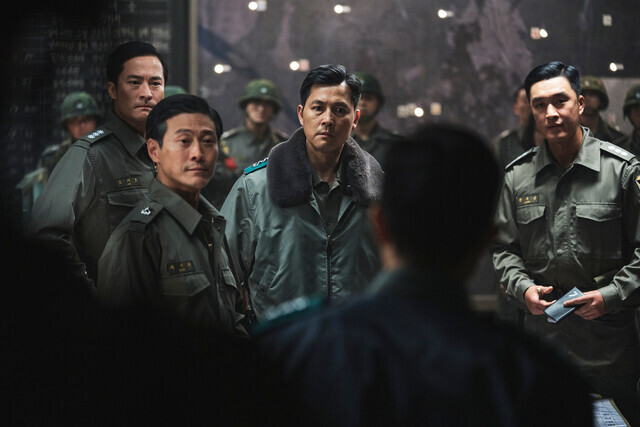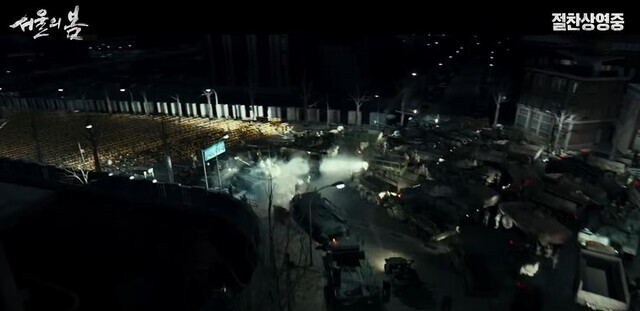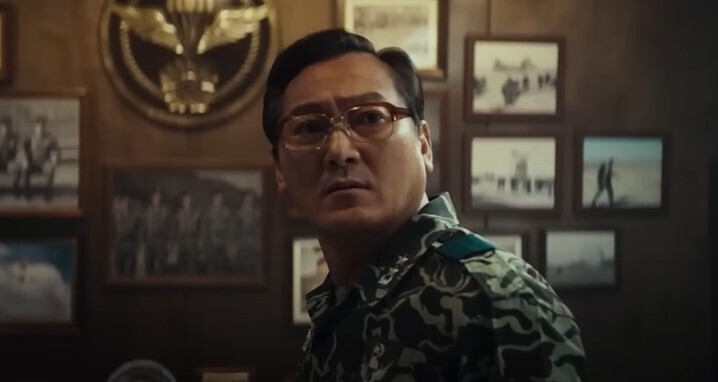hankyoreh
Links to other country sites 다른 나라 사이트 링크
The harrowing real-life stories of the Korean military coup depicted in “12.12: The Day”

As of Saturday, “12.12: The Day” had attracted over 1.89 million viewers to Korean box offices a mere five days after its release. The film focuses on the nine-hour military coup that occurred on Dec. 12, 1979, that brought Chun Doo-hwan to power.
Since the film is based on true events that were creatively embellished for dramatic purposes, many viewers have become curious about the historical facts. The film depicts firefights where both the insurgents and the military spill blood on the streets of Seoul. Did that really happen? Let’s separate fact from fiction.
※ This article contains spoilers for the film “12.12: The Day.”

The film shows Chun Doo-gwang (played by Hwang Jung-min), a character based on former military dictator Chun Doo-hwan, leading a military insurrection. Opposing Chun’s insurrection are Capital Garrison Commander Lee Tae-shin (Jung Woo-sung), Maj. Gen. Gong Soo-hyuk (Jung Man-sik), and Brig. Gen. Kim Jun-yeob (Kim Sung-kyun). These characters are based on real-life officers: Capital Garrison Commander Jang Tae-wan, Maj. Gen. Jeong Byeong-ju, and Brig. Gen. Kim Jin-ki.
The film primarily focuses on the conflict between Chun Doo-kwang and Lee Tae-shin. One of Lee’s most memorable lines is when he tells the rebels, “Wait for me, and don’t you move a muscle. I’m going to drive this tank over there and crush your skulls.” Online news site Sisa Journal published journal entries of the real-life Jang Tae-wan in 2006. The entries recall a phone conversation with the insurrectionists, in which Jang yells, “I’m going to drive my tank over there and crush all of your skulls.” Lee Tae-shin can be seen as a fairly true-to-life depiction of the character and behavior of the real-life Jang Tae-wan.
After the coup succeeded and the insurrectionists took over, the lives of Jang and his family spiraled downward into a continuous tragedy. Jang was sent to the infamous interrogation facility known as the “Seobinggo Hotel,” where he was tortured and forcibly transferred to an obscure position. He was also subjected to six months of house arrest. Jang’s father was so enraged by the events that he quit eating and drank himself to death in 1980. Jang’s son, a former student at Seoul National University, was found dead in front of his grandfather’s grave two years later. The cause of his death remains a mystery. Jang’s family was torn to pieces in the wake of the coup.
Later, when Chun Doo-hwan and Roh Tae-woo finally faced their day of judgment in court, Jang recovered his status as a “proper soldier.” He was elected as a National Assembly lawmaker in 2000, and lived the rest of his life as a politician. He died on July 26, 2010, at 79 years old. But the tragedy doesn’t end there. Two years later, Jang’s wife took her own life after leaving a note.

The film’s climax depicts the insurrectionists facing off against the military’s Capital Garrison Command in front of Gyeongbok Palace, in what we now know as Gwanghwamun Plaza. Leading a force of around 100 soldiers (including non-combatants) and four tanks, Lee Tae-shin charges at the insurrectionists’ barricade. He orders his artillery unit to prepare to shell the location where the insurrectionists have bunkered in. Although it’s in the dark of night, the battle ensues in the middle of the city. Civilian casualties are to be expected, which adds to the tension of the scene.
In reality, no such firefight happened. In the wee hours of Dec. 12, Jang Tae-wan did assemble a force that included non-combatants, but he received vehement opposition from his officers. The rebel forces had already taken Army Headquarters, and Jang concluded that a counteroffensive was untenable. Jang wrote about the situation in his journal.
“’... It looks like it’s all over. Better head up to the office and prepare for the aftermath.’ That’s what my chief secretary advised. Intuitively, I know that the Capital Garrison Command is no longer under my control, and my troops are no longer under my command. Just after 24 days in command, I now realize that I never had any troops under my command to begin with. As the chief secretary advised, I headed up to my office. It was Dec. 13, 01:31 am.”
Jang later described himself as a “criminal who failed to uphold his duties as the commander of the Capital Garrison Command.”

Maj. Kim Oh-rang’s last stand
In another memorable scene, when insurrection forces storm the command center to arrest Maj. Gen. Gong Soo-hyuk, Maj. Oh Jin-ho bravely fights to the last breath. Kim Oh-rang is portrayed by Jung Hae-in.
“I can’t leave you alone, major general. You’ll be too lonesome,” Oh says after refusing to flee.
The scene recalls another soldier Jung plays: Pvt. Ahn Jun-ho, in the Netflix series “D.P.” The subconscious association somehow makes the scene even more tragic.
Oh is based on Maj. Kim Oh-rang. In the early hours of Dec. 13, 1979, the 3rd Special Forces Brigade (Airborne), which had joined the rebel forces, stormed the Army Special Warfare Command headquarters to arrest Maj. Gen. Jeong Byeong-ju. The command center was located in Seoul’s Songpa District, the same district that houses today’s Lotte World theme park. Few combat troops were left at the command center, leaving Jeong effectively isolated. His only protection was his right-hand man, Maj. Kim Oh-rang. Armed only with a pistol, Oh bravely faced several soldiers armed with M16 rifles until his last breath. Jeong was shot in the left arm, but survived.

The tragedy continues. After a forced transfer to a lower position, Jeong reportedly battled with depression. He repeatedly called for a fact-finding mission and the reinstatement of his title and honor, but he was discovered dead on a hill on the outskirts of Seoul in March 1989. Police concluded that he’d died by suicide. Papers like the Hankyoreh and Joongang Ilbo reported that his death appeared to be suspicious.
Kim Oh-rang’s wife, Baek Yeong-ok, was apparently so traumatized by her husband’s death that she went blind from paralysis of her optic nerve. She lived a painful life and was discovered dead in June 1991. Police reported that she’d died from a fall. Kim was posthumously promoted to lieutenant colonel in 1990. In 2014, he was posthumously awarded the Order of National Security Merit.
Enlisted rank soldiers died as well as officers. The film depicts a soldier who dies while defending an underground bunker that links Army Headquarters and the Ministry of National Defense. This soldier is based on a real-life marine named Jeong Seon-yeob. He was just three months shy of being discharged when he was killed by the insurrectionists. Pvt. Park Yun-gwan was escorting Army Chief of Staff Jeong Seung-hwa, who had sided with the rebels, when he was killed in a firefight.
More details about their death are provided by a 2013 crowdsourced campaign, Find Chun Doo-hwan’s Assets: https://hani.com/u/ODM4Mg (Only available in Korean.)

The truth is often stranger than fiction. On Thursday, the day of the film’s release, a group of retired servicemen banded together with an activist group to commemorate Chun Doo-hwan, the real-life leader of the coup who died two years ago on the same day, Nov. 23. Chun, who was later sentenced to death for his ruthless suppression of protesters in Gwangju but pardoned by then-President Kim Young-sam, was ordered by the government to pay a fine of 220.5 billion won (US$170.9 million) in 1997. He still had over 92 billion won (US$71.3 million) in unpaid fines when he died.

By Lee Seung-jun, staff reporter
Please direct questions or comments to [english@hani.co.kr]

Editorial・opinion
![[Column] Season 2 of special prosecutor probe may be coming to Korea soon [Column] Season 2 of special prosecutor probe may be coming to Korea soon](https://flexible.img.hani.co.kr/flexible/normal/500/300/imgdb/original/2024/0426/3317141030699447.jpg) [Column] Season 2 of special prosecutor probe may be coming to Korea soon
[Column] Season 2 of special prosecutor probe may be coming to Korea soon![[Column] Park Geun-hye déjà vu in Yoon Suk-yeol [Column] Park Geun-hye déjà vu in Yoon Suk-yeol](https://flexible.img.hani.co.kr/flexible/normal/500/300/imgdb/original/2024/0424/651713945113788.jpg) [Column] Park Geun-hye déjà vu in Yoon Suk-yeol
[Column] Park Geun-hye déjà vu in Yoon Suk-yeol- [Editorial] New weight of N. Korea’s nuclear threats makes dialogue all the more urgent
- [Guest essay] The real reason Korea’s new right wants to dub Rhee a founding father
- [Column] ‘Choson’: Is it time we start referring to N. Korea in its own terms?
- [Editorial] Japan’s rewriting of history with Korea has gone too far
- [Column] The president’s questionable capacity for dialogue
- [Column] Are chaebol firms just pizza pies for families to divvy up as they please?
- [Column] Has Korea, too, crossed the Rubicon on China?
- [Correspondent’s column] In Japan’s alliance with US, echoes of its past alliances with UK
Most viewed articles
- 1AI is catching up with humans at a ‘shocking’ rate
- 2[Column] Season 2 of special prosecutor probe may be coming to Korea soon
- 3‘We must say no’: Seoul defense chief on Korean, USFK involvement in hypothetical Taiwan crisis
- 4Is Japan about to snatch control of Line messenger from Korea’s Naver?
- 5The dream K-drama boyfriend stealing hearts and screens in Japan
- 6Amnesty notes ‘erosion’ of freedom of expression in Korea in annual human rights report
- 7Up-and-coming Indonesian group StarBe spills what it learned during K-pop training in Seoul
- 8[Column] Action on climate change isn’t driving inflation – fossil fuels are
- 9[Column] ‘Choson’: Is it time we start referring to N. Korea in its own terms?
- 10Korea sees more deaths than births for 52nd consecutive month in February